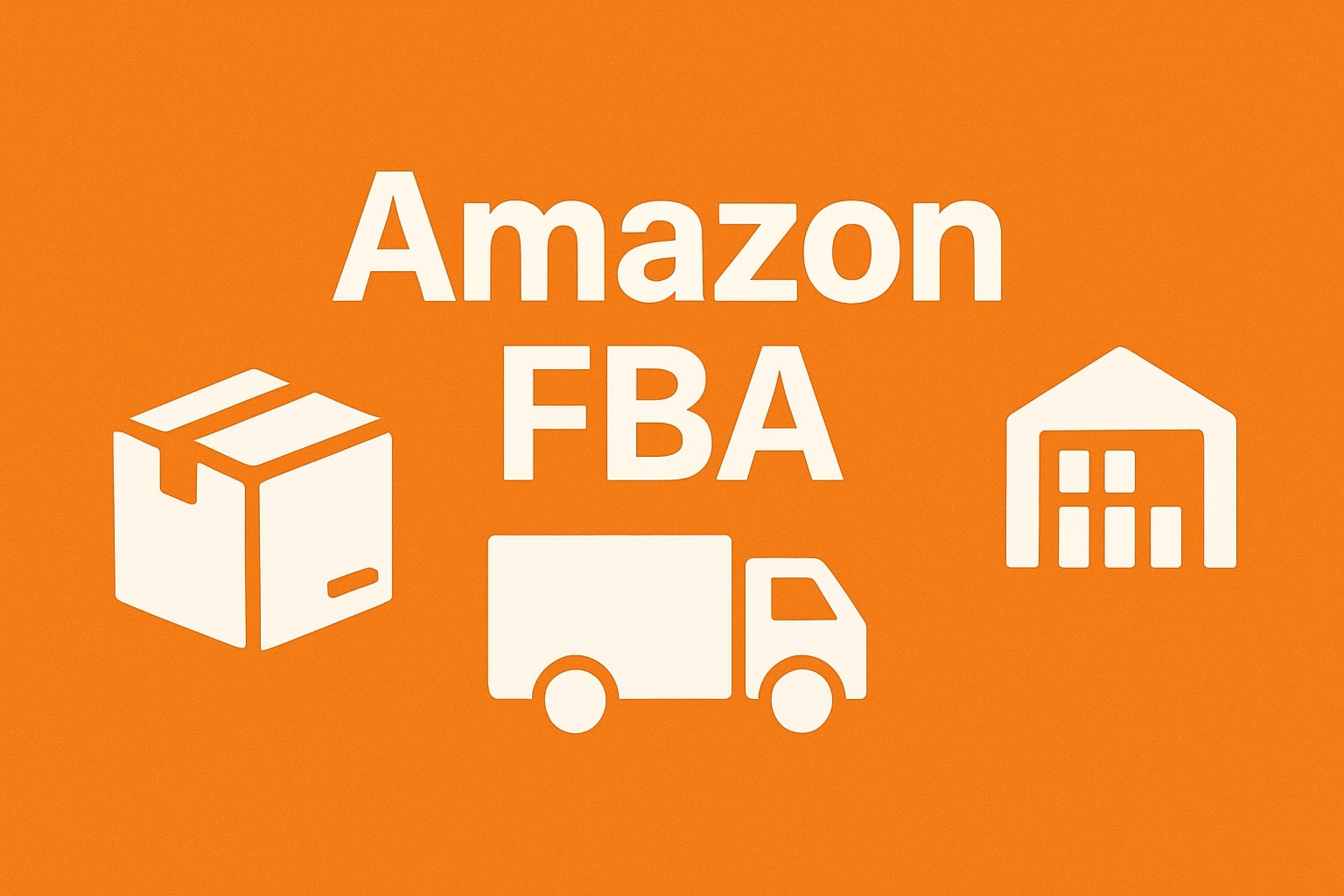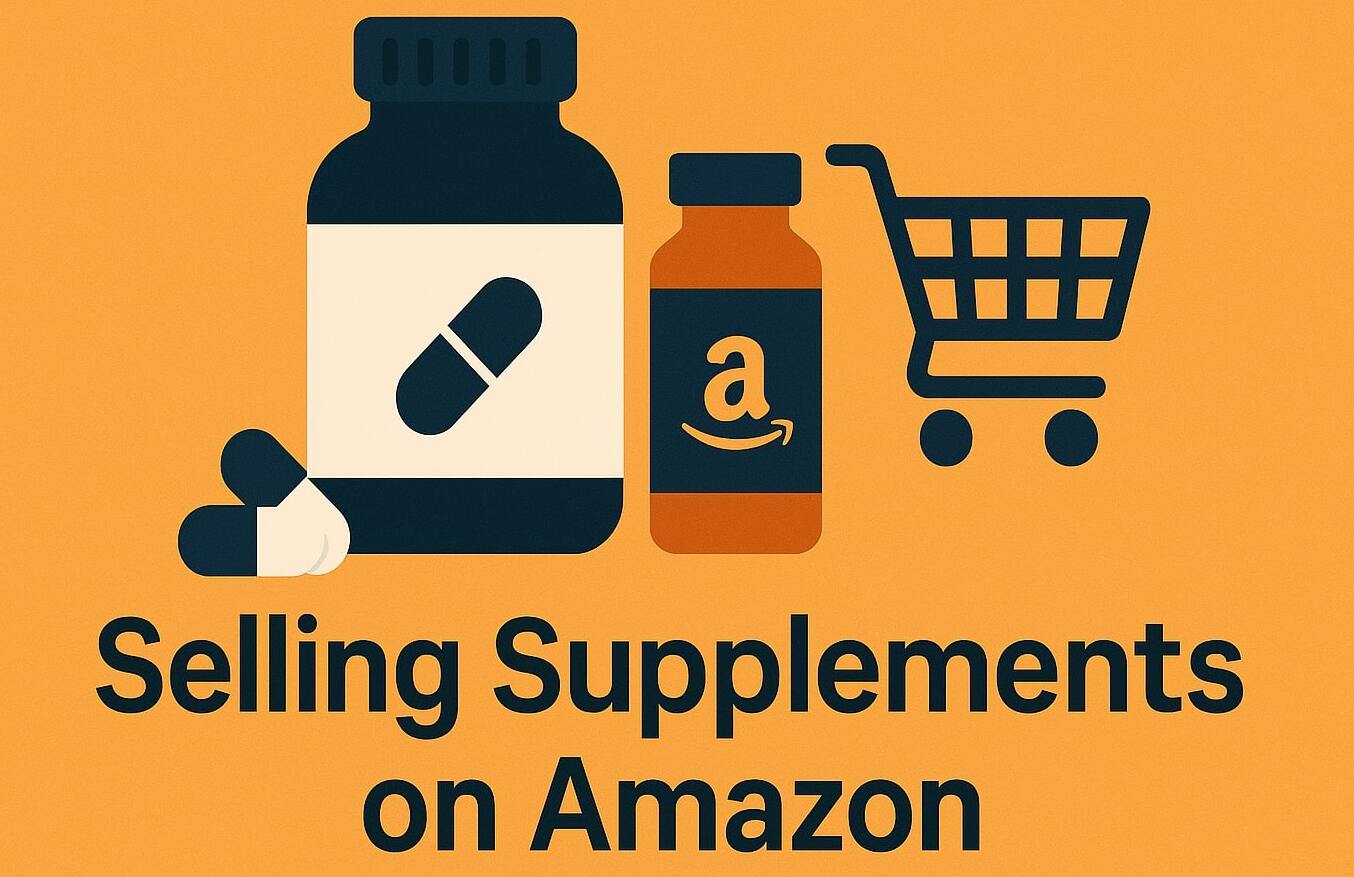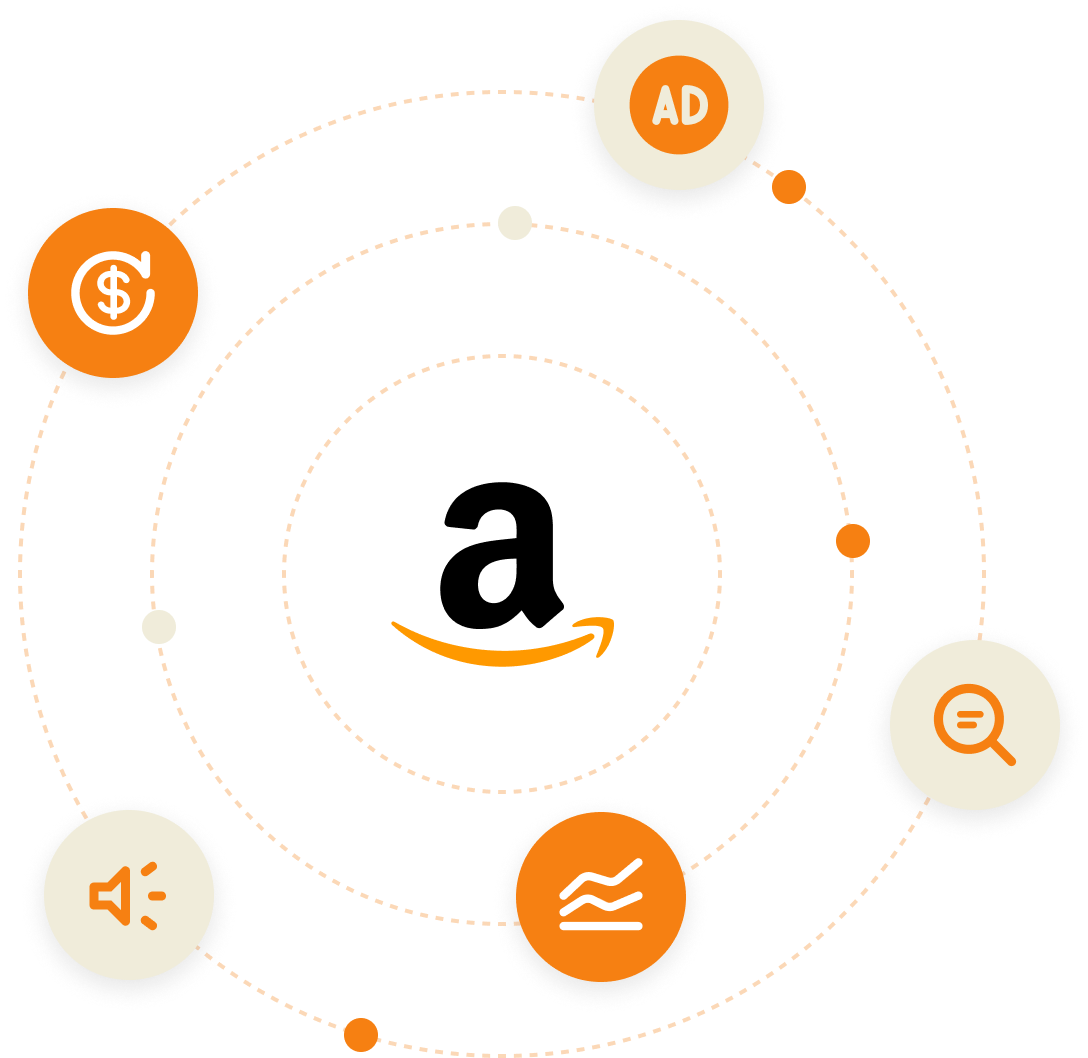Selling on Amazon has become a popular way to start a side hustle and earn extra income. With millions of daily shoppers, the Amazon FBA (Fulfillment by Amazon) program makes it even easier by handling storage, packaging, and shipping through Amazon’s warehouse network.
The potential is huge—nearly 60% of Amazon sellers earn between $1,000 and $25,000 in monthly sales, with some reaching six-figure incomes annually. Amazon offers tools like FBA and advertising options to help sellers succeed.
Whether you’re looking to boost your income or dive into entrepreneurship, Amazon FBA is a proven gateway with minimal upfront investment needed. Here’s everything you need to know to get started.
Is Your Amazon Store Reaching Its Full Potential?
Discover hidden opportunities, reduce wasted spend, and boost your sales with a free expert audit.
Our team will analyze your listings, ad performance, and overall account health to uncover exactly what’s working—and what’s holding you back. You’ll get a tailored blueprint to scale smarter, not harder.
Get a Free AuditWhat Is Amazon FBA?
Amazon FBA, or Fulfillment by Amazon, is a service that allows sellers to store their products in Amazon’s warehouses. Amazon then handles storage, packaging, shipping, and even customer service on behalf of the seller.
With FBA, you can scale your business by reaching millions of Amazon’s customers globally. It also frees up your time, allowing you to focus on growing your brand and sourcing new products. All of these tasks are handled by Amazon, which means it saves you the hassle and costs of managing your own warehouse and fulfillment process.
How Does Amazon FBA Work?
On Amazon’s end, FBA is a simple process. Amazon benefits from the FBA program by expanding its product offerings, earning fees from sellers for storage and fulfillment, and strengthening customer loyalty through faster shipping and reliable service.
When a customer places an order with you, Amazon picks, packs, and ships the product directly to the customer’s doorstep. Customers also have access to Prime shipping benefits when purchasing from FBA sellers, which can increase their chances of making sales and gaining loyal customers.
On the seller’s end, Amazon FBA works through a few simple steps (all of which will be described in a separate section below). Fulfillment by Amazon (FBA) allows sellers to store their products in Amazon’s fulfillment centers, where Amazon handles picking, packing, shipping, and customer service, enabling sellers to scale their businesses efficiently. Pricing is based a pay-as-you-go fee structure, depending on storage space and how many orders FBA fulfills for you.
As of 2025, 82% of Amazon sellers use FBA. And there are very good reasons for it: Amazon FBA really is quite advantageous for everyone involved. Amazon FBA makes fulfillment hassle-free, it opens opportunities for businesses that otherwise wouldn’t exist, and it is a win-win situation for Amazon because FBA sellers sell more. And on the other end of the stick, customers get their products in time, safely, and reliably.
Different Amazon Business Models
To understand if Amazon FBA is right for you, you must first understand if it suits your business model. There are five different types of Amazon business models you can adopt, and each of them has its own advantages and disadvantages.
Here’s what you need to know about them:
Private Label
Private labeling involves creating your own branded products to sell. You work with a manufacturer to produce an item with your unique branding or customization, and then sell it under your label.
The main advantages in selling private label products on Amazon include:
- Higher profit margins, as you control the pricing and can find cheaper manufacturing options.
- More control over your brand and product quality.
The main disadvantages include:
- The initial investment required for research, development, and production of your branded products.
- The risk of not being able to differentiate your product from others in the market or failing to generate sales.
- It can get time-consuming to build a product (and find the right product-market fit for it)
Private label businesses tend to benefit the most from Amazon FBA. With Fulfilment by Amazon, you can store your private label products in Amazon’s warehouses. Amazon handles shipping, returns, and customer service, allowing you to focus on marketing and growing your brand.
Examples of private label businesses selling on Amazon include Anker (high-quality electronics at affordable prices) and Nature’s Bounty (vitamins, supplements, and .
Wholesale
Wholesale involves purchasing products in bulk from manufacturers or distributors and reselling them on Amazon. Unlike private label, with a wholesale business model, you sell pre-existing branded Amazon products.
There are advantages to choosing this business model on Amazon:
- Lower risk and initial investment, as you’re not creating new products from scratch.
- Established brands and products can have a higher demand and easier time gaining traction on Amazon.
…Just as there are disadvantages:
- Tight profit margins due to competition with other sellers selling the same product.
- Limited control over pricing, branding, and product quality.
- Difficulty in finding reliable suppliers or negotiating deals for bulk purchases.
Wholesale businesses can also benefit from Amazon FBA by using its fulfillment services for storing, packing, and shipping their products. This allows them to focus on finding profitable products and growing their sales.
Reselling/ Onlibe arbitrage
Reselling (or online arbitrage/ retail arbitrage) involves buying products from other retailers or online stores at a lower price and reselling them on Amazon at a higher price. This business model allows for quick turnover and low investment, but it also comes with its own set of risks and challenges.
Some advantagesof reselling on Amazon include:
- Low barriers to entry, as you don’t need any product development or sourcing skills.
- Quick turnaround time and high potential for profit due to the difference in prices between different selling platforms.
- The ability to test demand for a product before committing to large bulk purchases.
And some disadvantages include:
- High competition, as anyone can easily start reselling on Amazon.
- The risk of running out of stock or facing price fluctuations on other selling platforms.
- Difficulty in finding profitable products to resell and staying ahead of trends.
Amazon FBA can be beneficial for resellers, as it allows them to store their inventory in Amazon’s warehouses and have Amazon handle the fulfillment process. However, professional sellers must carefully track profit margins and Amazon fees to ensure they are making a profit with this business model.
Dropshipping
Dropshipping involves listing products on your online store without actually holding any inventory. When an order is placed, you purchase the product from a third-party supplier who then directly ships it to the customer. This business model has gained popularity due to its low barriers to entry, but it also comes with some challenges.
Some advantages of dropshipping on Amazon include:
- Low initial investment and overhead costs.
- No need for product sourcing or inventory management.
- Flexibility in testing different products without committing to bulk purchases.
However, there are also some disadvantages, such as:
- Higher competition from other dropshippers and FBA sellers.
- Lower profit margins due to fees and additional costs associated with using a third-party supplier.
- Limited control over product quality, shipping times, and customer service.
Amazon has strict policies regarding dropshipping, so be sure to thoroughly research their guidelines before deciding to use this business model on the platform.
Handmade
Handmade allows artists and artisans to sell their handmade or handcrafted products on Amazon. This business model has its own specific set of requirements and guidelines, but it can be a great option for those with creative skills.
Some advantages of selling handmade products on Amazon include:
- A niche market with less competition compared to other categories.
- The ability to showcase unique and one-of-a-kind products.
- Potential for higher profit margins due to the value placed on handmade items.
But there are some disadvantages, such as:
- Strict guidelines and regulations regarding what can be considered “handmade.”
- Difficulty in scaling the business due to time-consuming production processes.
- The potential for counterfeit products to be listed under the handmade category.
Amazon Handmade can be a great platform for artists and artisans to showcase their talents, but it’s important to carefully follow Amazon’s guidelines and continuously monitor your listings for any infringement issues.
Amazon FBA Step by Step: How to Get Started
Starting with Amazon FBA is quite straightforward. All you need is to:
1. Create an Amazon Seller account
Start by signing up for an Amazon Seller account through Amazon Seller Central. You can choose between an Individual or Professional plan, depending on your goals. Setting up your account includes providing business information, payment details, and tax identification. This is the first step to becoming part of Amazon’s global marketplace.
2. Identify a product
Research and identify a product that has high demand but low competition. Use tools like Jungle Scout or Helium 10 to analyze market trends and find profitable niches. Look for products that solve a problem, are lightweight, and have a competitive price point. The right product can make all the difference in your Amazon journey.
3. Source that product & ship it to the Amazon Warehouse
Once you’ve chosen a product, find a reliable supplier. You can use platforms like Alibaba or work with local manufacturers. Ensure the product meets quality standards, and negotiate prices to maximize profitability. After sourcing, ship your inventory to an Amazon Fulfillment Center through the FBA (Fulfillment by Amazon) program, which handles storage, packaging, and shipping for you.
4. Build and optimize your product listing
Create a compelling product listing that stands out. Write a detailed product description, use bullet points for key features, and include high-quality images that highlight your product’s benefits. Use relevant keywords in your title and description to improve visibility in search results. A well-optimized listing can significantly boost your sales.
5. Run Amazon PPC ads
Amazon Pay-Per-Click (PPC) ads are essential to driving traffic to your product. Set up campaigns targeting relevant keywords and monitor their performance regularly. PPC ads allow you to promote your product to potential customers directly on Amazon, helping you gain visibility and drive sales.
6. Build and encourage reviews
Positive reviews are crucial for building trust with potential buyers. Encourage satisfied customers to leave reviews by providing exceptional service and follow-up emails. Consider enrolling your product in the Amazon Early Reviewer Program or offering a product insert politely asking for feedback. A steady stream of good reviews boosts your product’s credibility.
7. Monitor the performance of your product
Regularly track your product’s performance using Amazon Seller Central’s analytics tools. Monitor metrics like sales, conversion rates, and customer feedback. Adjust your marketing strategy or product listing based on these insights to continually optimize performance.
8. Repeat, test new products, and scale
Once you’ve mastered the process with one product, repeat it with additional items. Test different niches and expand your catalog. Scaling your Amazon business allows you to reach more customers, diversify revenue streams, and grow your brand over time.
How to find profitable products to sell?
Finding profitable products is one of the most important steps to take when you want to be successful on Amazon. And while there is no set recipe for doing this, there are some factors you could use to better assess your options. Here are a few tips on how to find profitable products to sell on Amazon:
1. Research current market trends and product demand
Use tools like Jungle Scout, Helium 10, or Google Trends to analyze popular products and identify any gaps in the market that you could potentially fill with your own product. Look for products with consistent sales patterns and avoid fads or seasonal items.
2. Consider sourcing from overseas
Sourcing products from countries like China can often lead to lower production costs and higher profit margins. However, be sure to thoroughly research suppliers and quality control measures before making a bulk purchase.
3. Find products that solve a problem or fulfill a need
Finding products that solve a common problem or fulfill a specific need means you are likely to deal with high demand and higher profitability. Look for products that provide a solution, make life easier, or offer convenience to potential customers.
4. Choose lightweight and easy-to-ship items
Avoid bulky and heavy items as they can lead to higher shipping costs and lower profit margins. Opt for lightweight products that are easy to ship, reducing expenses and increasing efficiency.
5. Price your product competitively
Research the prices of similar products on Amazon and aim to price yours competitively. A high price could discourage potential buyers, while a low price may signal poor quality. Find the sweet spot where you can still make a profit while offering a fair price.
6. Keep an eye on your competition
It’s essential to regularly monitor your competitors’ prices, product features, and customer reviews. This will help you adjust your strategy and stay ahead of the game.
7. Test and gather feedback before investing in large quantities
Before investing in large inventory levels, it’s crucial to test the market with a smaller batch first. Gather feedback from customers through reviews or surveys to assess the demand for your product and make any necessary improvements before scaling up.
Want to know more about picking winning products to sell? Here is our guide to best selling products on Amazon.
What products sell on Amazon the most?
Selling on Amazon can be highly rewarding, but it’s important to carefully evaluate whether it’s the right fit for you. Some of the best-selling product categories include:
- Electronics (Popular and high demand, but has high competition and often low-profit margins).
- Home and Kitchen (Steady demand and broad audience, but can face storage and shipping challenges due to size).
- Beauty and Personal Care (Recurrent purchases and loyal customers, but requires compliance with strict regulations).
- Toys and Games (Seasonal spikes and strong margins, but trends can change rapidly, leading to unsold inventory).
- Clothing and Apparel (A vast market with opportunities to build a brand, but sizing variations can lead to high return rates).
- Health and Wellness (Growing interest in wellness trends, but can involve regulatory concerns and liability risks).
- Sports and Outdoors (Consistently in demand, but larger items can increase shipping costs).
- Pet Supplies (Pet ownership is rising, fostering demand, but heavy competition exists in niche areas).
How to source products for Amazon FBA
When you start selling with Amazon FBA, you want to be certain you can ensure a steady supply of products. The quality of your suppliers is just as important as the quality of the products themselves, especially (but not only) during spike seasons (like the one between Black Friday and Christmas, for example).
Some of the main things to consider when sourcing your products include:
- Product quality and compliance – Make sure your suppliers provide high-quality products that comply with all regulations and safety standards. Request product samples before making bulk purchases to ensure consistency.
- Communication and reliability – Choose suppliers who are responsive and have a good track record for meeting deadlines and delivering on time. This will help you maintain a good relationship with your customers by ensuring timely delivery of orders.
- Pricing and negotiation – Negotiate the best price possible, but also consider the cost of shipping, packaging, and other unexpected expenses. Make sure to factor these into the overall cost when determining profit margins.
- Payment terms – Choose suppliers with reasonable payment terms that work for your business
Don’t be afraid to think out of the box and look into places that seem counter-intuitive. For example, here’s how you can source high-quality products from Japan, for your Amazon FBA:
https://www.youtube.com/watch?v=yds5vLKr3Xs
Also, keep in mind Trivium Group can help you build a winning Amazon selling and marketing strategy. We have collected experience of more than three decades in helping Amazon businesses achieve and overcome their goals, so contact us ofand let’s talk about your business plans!
Tips to increase sales on Amazon
Boosting your sales on Amazon might feel like Mission Impossible, but it doesn’t have to be. Yes, the competition is fierce in most niches, but following best practices and tinkering with your product listings can make a big difference.
Here are five tips to increase your sales on Amazon:
Optimize your product listings and keywords , giving your brand a lasting competitive edge.
Ensure your product listings are fully optimized to increase visibility in Amazon’s search results. Use targeted keywords in your titles, descriptions, and bullet points to align with what potential buyers are searching for. Focus on clarity and relevance when describing your product’s features and benefits. Well-optimized listings not only improve search rankings but also help customers quickly understand what makes your product stand out.
Leverage customer reviews and ratings
Customer reviews and ratings are essential for building trust and credibility with potential buyers. Encourage satisfied customers to leave positive reviews by providing an excellent shopping experience. Respond promptly and professionally to any negative feedback to show you care about customer satisfaction. A higher number of positive reviews can significantly influence purchase decisions and enhance your product’s reputation.
Take advantage of promotions and deals
Use Amazon’s promotional tools, such as Lightning Deals, Coupons, or Subscribe & Save, to incentivize purchases and boost sales. Promotions can create urgency and encourage customers to choose your product over competitors. These tools not only improve visibility but can also help you attract new buyers, increase conversion rates, and clear out inventory quickly when needed.
Use social media platforms
Expand your reach by promoting your Amazon products on social media platforms like Instagram, Facebook, or even TikTok. Share engaging content, such as high-quality images or videos of your product in use, to capture attention and drive traffic to your listings. Social media can help you connect with a broader audience and build a loyal customer base outside of Amazon’s marketplace.
Offer excellent customer service
Deliver outstanding customer service to ensure a seamless shopping experience. Respond to customer inquiries quickly and provide clear, accurate information about your products. Make returns and refunds hassle-free to build trust and loyalty. A strong reputation for customer service can result in positive reviews and repeat buyers.
Struggling to Scale on Amazon?
Get a free expert audit and uncover quick wins to boost sales and cut ad waste.
Get a Free AuditConclusion
One of the main reasons so many eCommerce businesses are drawn to Amazon as a platform is because it acts as more than just a marketplace: it provides you with all the tools you need to succeed. Amazon FBA is precisely that: a tool to help you succeed.
Using it in the right way and following best practices, such as sourcing high-quality products and optimizing your listings, you can increase sales and build a successful business on Amazon. And with the added support of companies like Trivium Group, you can take your Amazon selling game to the next level.
Remember that success on Amazon takes time and effort, but with dedication and the right strategy, your business can thrive in this ever-growing marketplace. So keep learning, adapting to changes, and implementing new strategies to stay ahead of the competition and achieve your goals with Amazon FBA. The possibilities are endless.
And, as mentioned before, don’t hesitate to reach out and book a meeting with us if you need professional Amazon marketing services. We’d be more than happy to help out. In the meantime, feel free to check out our case studies and learn more about our previous clients’ success.
FAQs
Yes, sellers pay shipping costs when sending inventory to an Amazon warehouse. However, you can use Amazon’s discounted shipping rates to reduce expenses.
Earnings vary widely, but many Amazon sellers make between $1,000 and $25,000 per month in sales. Profit depends on product selection, pricing, and marketing strategies.
Amazon FBA costs depend on factors like storage fees, fulfillment fees, and optional services. On average, expect to pay around 15-30% of your product’s selling price.
Yes, Amazon FBA is beginner-friendly, as it handles logistics and simplifies operations. With FBA, beginners don’t need to worry about warehousing, packing, or shipping their products, as Amazon takes care of it all. This allows new sellers to focus on sourcing the right products and building their business. However, beginners should be cautious about choosing products with low demand or poor profit margins, as these can quickly lead to losses. It’s essential to do thorough product research and understand market trends before diving in.
Amazon FBA is worth it for sellers who want to streamline storage, shipping, and customer service. However, it works best if you sell high-demand products with healthy profit margins.
You can source products from wholesalers, manufacturers, liquidation sales, or online marketplaces like Alibaba. Choose suppliers with quality products and competitive pricing.




